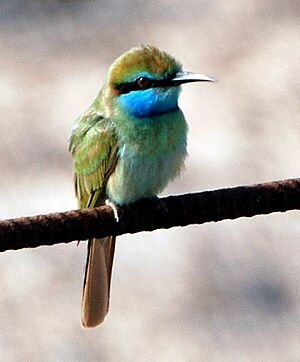Arabian green bee-eater facts for kids
Quick facts for kids Arabian green bee-eater |
|
|---|---|
 |
|
| Conservation status | |
| Scientific classification | |
| Genus: |
Merops
|
| Species: |
cyanophrys
|
The Arabian green bee-eater (Merops cyanophrys) is a beautiful bird. It belongs to the Meropidae family, which are known for eating insects. You can find this bird in dry areas of the Arabian Peninsula. This includes countries like Saudi Arabia, Yemen, Oman, and the United Arab Emirates. In recent years, it has even spread north to places like Israel and Jordan.
Contents
About the Arabian Green Bee-Eater
How Scientists Classify Birds
Scientists often study birds to understand how they are related. Sometimes, birds that look similar are grouped together. For a while, the Arabian green bee-eater was thought to be the same species as the African green bee-eater and the Asian green bee-eater.
However, in 2014, experts decided they were different species again. A study in 2020 looked closely at how they looked and sounded. It found clear differences between all three. So, in 2021, they were officially recognized as separate species.
Different Types of Arabian Green Bee-Eaters
Within the Arabian green bee-eater species, there are two main types. These are called subspecies. They have slight differences depending on where they live:
- M. c. cyanophrys: This type lives in the western and southern Arabian Peninsula. You can also find it in southern Israel.
- M. c. muscatensis: This type lives in the central and eastern Arabian Peninsula.
What Does It Look Like?
The Arabian green bee-eater is a colorful bird. It has bright green feathers. You can tell it apart from other similar bee-eaters by a few key features.
It has shorter central tail feathers. Its forehead, the area above its eye (called the supercilium), and its throat are blue. It also has a wider black band across its chest. Its calls and songs are also different from its relatives.
Where Do They Live?
You can find the Arabian green bee-eater in dry, open areas of the Middle East. They like places with scattered trees. They also live in wadis (dry riverbeds), gardens, and farmlands.
Their range stretches from western and central Saudi Arabia south to Yemen. They also live north to Oman and the eastern United Arab Emirates. Some even live on small islands off the western UAE coast.
How Their Home is Changing
Interestingly, this bird's population has grown. This is partly because of farming and irrigation. These activities create new, good places for them to live. Because of this, they have been able to move into new areas. Before 2001, they started living in parts of the Levant. This includes eastern Israel, western Jordan, and a small part of the Sinai Peninsula.
Since their population is growing and they benefit from human changes to the land, they are not considered to be in danger.


